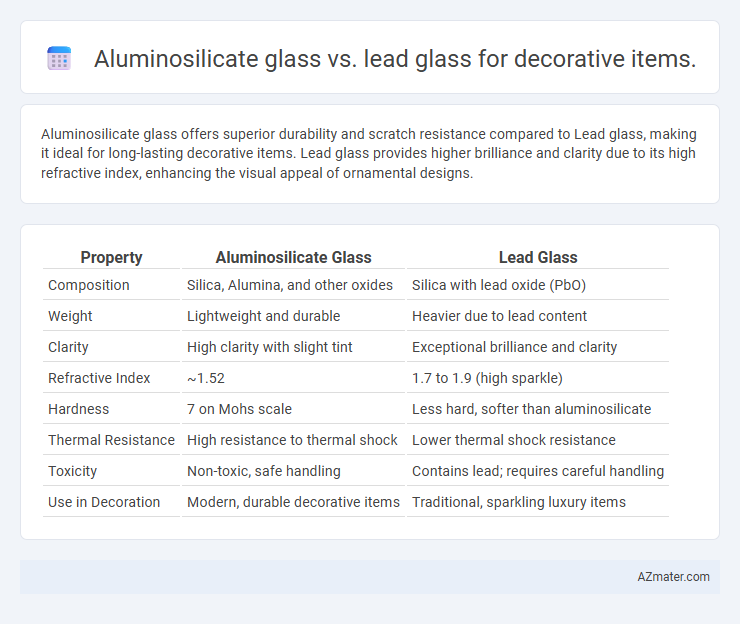Aluminosilicate glass offers superior durability and scratch resistance compared to Lead glass, making it ideal for long-lasting decorative items. Lead glass provides higher brilliance and clarity due to its high refractive index, enhancing the visual appeal of ornamental designs.
Table of Comparison
| Property | Aluminosilicate Glass | Lead Glass |
|---|---|---|
| Composition | Silica, Alumina, and other oxides | Silica with lead oxide (PbO) |
| Weight | Lightweight and durable | Heavier due to lead content |
| Clarity | High clarity with slight tint | Exceptional brilliance and clarity |
| Refractive Index | ~1.52 | 1.7 to 1.9 (high sparkle) |
| Hardness | 7 on Mohs scale | Less hard, softer than aluminosilicate |
| Thermal Resistance | High resistance to thermal shock | Lower thermal shock resistance |
| Toxicity | Non-toxic, safe handling | Contains lead; requires careful handling |
| Use in Decoration | Modern, durable decorative items | Traditional, sparkling luxury items |
Introduction to Decorative Glass Types
Aluminosilicate glass offers high durability and resistance to thermal shock, making it ideal for intricate decorative items that require longevity and strength. Lead glass, known for its high refractive index and brilliance, enhances the aesthetic appeal of decorative pieces with exceptional clarity and sparkle. Choosing between aluminosilicate and lead glass depends on the balance between durability and optical elegance desired in decorative glass products.
What is Aluminosilicate Glass?
Aluminosilicate glass is a type of glass composed primarily of aluminum oxide (Al2O3) and silica (SiO2), known for its exceptional strength, thermal resistance, and durability compared to traditional glasses. This makes it highly suitable for decorative items requiring scratch resistance and longevity, as it resists impact and thermal shock better than lead glass. Unlike lead glass, which contains lead oxide to enhance optical clarity and weight, aluminosilicate glass offers a safer, eco-friendly alternative without compromising structural integrity or aesthetic appeal.
What is Lead Glass?
Lead glass, also known as lead crystal, contains lead oxide typically ranging from 18% to 40%, which enhances its brilliance and weight, making it highly favored for decorative items. Its high refractive index produces remarkable light dispersion and a sparkling appearance compared to aluminosilicate glass, which lacks lead content and offers greater durability but less optical brilliance. Lead glass is ideal for ornamental products like chandeliers, vases, and fine glassware where aesthetic appeal is prioritized over mechanical strength.
Key Differences in Chemical Composition
Aluminosilicate glass primarily consists of silicon dioxide (SiO2) and aluminum oxide (Al2O3), which contribute to its high strength and thermal stability, making it resistant to thermal shock. Lead glass contains a significant proportion of lead oxide (PbO), typically 18-40%, enhancing its density and refractive index, resulting in greater brilliance and weight. The absence of lead in aluminosilicate glass makes it safer and more environmentally friendly but less brilliant compared to the heavy, sparkling appearance of lead glass used in decorative items.
Optical Properties: Clarity and Brilliance
Aluminosilicate glass offers high durability and good chemical resistance but generally has lower refractive index and brilliance compared to lead glass. Lead glass, enriched with lead oxide, exhibits superior clarity and exceptional light dispersion, enhancing brilliance and sparkle in decorative items. The higher density and refractive index of lead glass make it the preferred choice for premium decorative pieces requiring stunning optical effects.
Durability and Strength Comparison
Aluminosilicate glass exhibits superior durability and impact resistance compared to lead glass, making it ideal for decorative items subjected to frequent handling or environmental stress. Its enhanced scratch resistance and greater mechanical strength ensure long-lasting clarity and structural integrity. Lead glass, while prized for its brilliance and decorative appeal, is more prone to chipping and has lower tensile strength, reducing its suitability for high-durability applications.
Safety and Environmental Considerations
Aluminosilicate glass offers superior safety compared to lead glass due to its lower toxicity and higher resistance to thermal shock, making it ideal for decorative items that require durability and non-hazardous materials. Lead glass contains lead oxide, which poses significant health risks from lead exposure and environmental contamination during manufacturing and disposal. Environmentally, aluminosilicate glass is more sustainable as it is easier to recycle and does not leach harmful substances, unlike lead glass, which requires careful handling to prevent ecological damage.
Design Flexibility and Aesthetic Appeal
Aluminosilicate glass offers superior design flexibility due to its high thermal durability and scratch resistance, enabling intricate shapes and vibrant finishes for decorative items. Lead glass, known for its high refractive index and clarity, enhances aesthetic appeal by producing brilliant light dispersion and a sparkling effect unmatched by aluminosilicate variants. While aluminosilicate glass excels in durability and modern design innovation, lead glass remains preferred for classic elegance and luxurious visual impact in decorative applications.
Cost and Maintenance Factors
Aluminosilicate glass offers higher durability and scratch resistance compared to lead glass, reducing maintenance efforts over time. Lead glass, while often more affordable initially, requires careful handling and regular cleaning to prevent dullness and maintain its brilliance. The long-term cost efficiency favors aluminosilicate glass due to its lower risk of damage and reduced replacement frequency in decorative items.
Choosing the Best Glass for Decorative Items
Aluminosilicate glass offers superior durability and scratch resistance compared to lead glass, making it ideal for decorative items exposed to frequent handling or environmental stress. Lead glass, known for its high refractive index and brilliant clarity, enhances light dispersion and creates stunning visual effects in decorative pieces. Selecting the best glass involves balancing Aluminosilicate glass's toughness with Lead glass's optical brilliance based on the specific aesthetic and functional requirements of the decorative item.

Infographic: Aluminosilicate glass vs Lead glass for Decorative item
 azmater.com
azmater.com